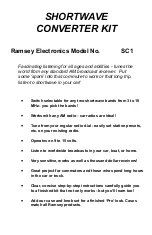
RS-232
↔
RS-485 INTERFACE CONVERTER
10
Table 3-3 contains definitions of all the jumpers
on the interface converter's printed-circuit board.
Table 3-3. Jumpers.
Jumper
Function
W1, W2, W3
These 16-pin DIP shunts are used to select DTE/DCE for the RS-485 port.
Install each in the DTE or DCE position as desired.
W4, W5
These 16-pin DIP shunts are used to select DTE/DCE for the RS-232 port.
Install each in the DTE or DCE position as desired.
W6
Selects RTS/CTS loopback delay for the RS-485 port when W9 is in the B-C
position (RTS-CTS loopback) as follows:
A=0 msec B=10 msec C=50 msec
W7
Selects RTS/CTS loopback delay for the RS-232 port when W10 is in the
A-B position (RTS-CTS loopback) as follows:
A=0 msec B=10 msec C=50 msec
W8
Position B-C: RS-485 transmitters are always enabled. This position should be
selected for four-wire applications.
Position A-B: tri-state control line of the RS-485 transmitters is driven by the
RS-232 equipment's RTS/CTS circuit.
NOTE: When W8 is in the B-C position, it overrides W9 and W10.
W9
Select RTS/CTS signal source for the RS-485 port as follows:
Position A-B: RS-485 RTS/CTS signal is driven by the RS-232 CTS signal.
Position B-C: RS-485 RTS/CTS signal is driven by the RTS/CTS
loopback/delay circuit.
W10
Selects RTS/CTS signal source for the RS-232 port as follows:
Position A-B: RS-232 RTS/CTS signal is driven by the
RTS/CTS loopback/delay circuit.
Position B-C: RS-232 RTS/CTS signal is driven by the RS-485 CTS signal.
W11
Connects the DC power supply common to AC power ground. This is a
soldered jumper which is left open as a factory default. If you wish, you can
hardwire it to provide both signal and frame ground.

































